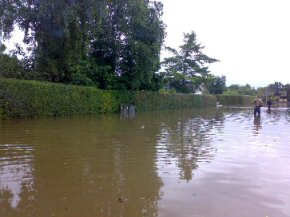Climate strategy in Greve
Adaptation of rainwater and watercourse systems to accommodate 30% more rain in 2100.
The council in Greve Municipality made a decision in 2008 to adapt the municipality's rainwater and watercourse systems to cope with climate change.
This decision was made because the municipality has experienced serious flooding twice within a few years. The first time was in 2002, when 100 mm of rain fell in 3 hours in the middle of the town of Greve and the stormwater drains were unable to carry the water away. The second time was in 2007, when 250 mm fell over a period of days and was distributed evenly throughout the entire municipality. This meant that the groundwater level in the municipality was very high, and when the last 50-70 mm fell there was extreme water flow in the watercourses. The watercourses have to pass through the town in order to reach Køge Bugt, and the "holes" through the town were too small, so the water ran on the surface into the town and through the stormwater drains instead.

Figure 1: Flooding in Greve, 2007 (Photo: Greve Forsyning)
The adaptation is expected to be completed in around 2020 and includes both existing and future runoff systems. Both the rainwater system and the watercourses are included in the adaptation. The aim is to achieve a runoff system which is upgraded to receive 30% more rain compared with 2008. The system will be designed for a 10-year rain in particularly vulnerable areas, corresponding at most to water standing on the ground every 10 years.
The upgrade will involve a number of different elements. As one of the main problems in respect of flooding involves watercourses bursting their banks, Greve has carried out groundwork in the area around Olsbækken to be able to accommodate more water. The rainwater network must also be upgraded. The municipality is divided into 42 urban areas, and in March 2009 the order of priority was defined for the areas to be climate-adapted. The solutions used up to now in Greve Midt involve optimisation of existing basins by rerouting pipes and guiding water to these, leading to an increase in existing pipes and establishment of new basins in green areas. The motto of the adaptation is that adaptation of an area must not adversely impact on a downstream area. Hence there is emphasis on the establishment of basins in the urban areas which can also be used for e.g. recreational purposes, and on establishing larger outlets to the coast so that discharge to the sea is assured in extreme situations.
The order of priority of these initiatives undergoes regular quality assurance by means of a computerised model. This model simulates water flows and water levels in watercourses and sewers, as well as on the ground. The model is gradually being improved by means of measurements and gathering of local experience. This information could give rise to changes to the order of priority.
The climate strategy also includes a contingency plan and establishment of groundwater monitoring. Data from monitoring is used in a digital groundwater model for the Olsbæk system's catchment, which should be able to provide warnings of situations like the one in 2007. Finally, the risk of flooding from the sea will be assessed in the project "Implementation of the EU's flooding directive in Greve."
Birgit Paludan, Greve Forsyning A/S: The policy decision concerning the "Strategy for climate adaptation" gives Greve Forsyning the opportunity to focus very strongly on climate adaptation for the town and preparing contingency plans as costs and finance have also been taken into account in the policymaking process.
Ongoing discussions on how much more rain we can expect in the future, along with how high the water level in the sea will be, present a major challenge with regard to when climate adaptation is to be carried out. A decision has been made to adapt Greve on the basis of the information available at the present time from IPCC and the Spildavandskomiteen (Waste Water Committee) under IDA, but in the future new knowledge will be submitted to Greve Council and the criteria for the climate adaptation will be adjusted if necessary.
Establishment costs (in DKK per red. ha.)
The climate adaptation is estimated to cost an amount running into many millions (3 figures), and this will be partly financed by water drainage funding.
Measurements and modelling are expected to cost DKK 2 - 4 million.
Contact
Name: Birgit Paludan, hydraulics specialist, graduate engineer
Organisation: Greve Forsyning A/S
E-mail: bpa@greve.dk
Telephone: +45 43 97 87 28

